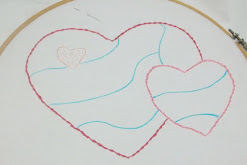I finished the embroidery sampler. I changed my original plan a bit. Originally I was going to do all the
stitching in the color of my logo. So
with the big heart, all the stitching would be done in the dark pink, and the lighter
pink in the medium heart. But I realized
that all the stitching would just blend together so you couldn’t tell what
stitches were what. So having done the
line or border stitches in one color, I did the individual stitches in between
the lines in the color of the other heart shape. I like it much better this way.
I went through my embroidery books to look for some stitch
ideas. I found some I like using like
the French knot and the fly stitch. Then
some I like but are challenging for me like the lazy daisy. And then some new stitches I wanted to try.
If you remember the little heart, I just did the seed
stitch. It wasn’t really big enough to
do multiple stitches and the seed stitch is another stitch I like to use.
For the medium heart, I actually started with the French
knot. I like using the French knot. It is one a lot of people have trouble with
but it is just one of those stitches that you have to practice, practice,
practice.
One of those stitches I found in my embroidery book and
thought would be fun to try.
It was the woven cross.
It starts off like a cross stitch but you repeat the same stitches
weaving the last stitch in and out of the other stitches.
Another stitch I am seeing a lot lately in embroidery books
but never tried is the sheaf stitch.
It is basically three straight stitches parallel to each other with a
fourth stitch gathering the three stitches in the middle. The do look like a sheaf of wheat. This was a fun stitch to do. I have seen it used a a filler but also used
at the bottom of a flower right above the stem.
Now for the big heart I had a lot of room to fills so I did
some combinations of stitches. The fly
stitch is one of my favorite. It is a
stitch like the start of feather stitch but instead of making another what I
call ‘U’ stitch next to the first one, You just make a little straight stitch
at the bottom to hold it in place. So in
one section I started with the fly stitch.
But then one book had a variation I had to fill the rest of
that section with. You do the fly stitch
but then add two more straight stitches on either side of the first one. It gives it the appearance of a crown which
is what this stitch is called.
I did something similar in another section. Started one end with a lazy daisy stitch
which is really just one link of the chain stitch (and this stitch is also know
as the link stitch).
Then on the other side I did a picot stitch (or lazy daisy
with a long tail stitch).
But then one book had a variation of the picot stitch called
the tulip stitch. You do the picot
stitch but on one side of the ‘chain’ you take a stitch and bring it under the anchor
stitch to the other side of the ‘chain’.
It gives it the appearance of leaves.
It was a fun stitch to try.
I did a simple star stitch around the little heart. I thought it helped frame the little heart in
the very light pink.
At the bottom of the big heart I did the pistil stitch which
is really just a French knot with a long tail.
It is great to add to a flower design in any embroidery. I thought it was a good match to the French
knots that are at the bottom of the medium heart.
And then finally I did the one stitch I always wanted to
try. It is called the woven spider
web. You take any odd number of straight
stitches embroidered like the spokes of a bicycle wheel and with an alternating
color you weave the second thread in and out of the spokes. You don’t want to pull the weaving too tight
or the stitches tend to hide under each other.
I liked how it turned out but I think it is better with a thicker
embroidery thread than the floss I used. It looks a bit like a flower so I am
going to have to try that one again.
This was fun, trying new stitches and deciding where and how
to display them. Now I just have to
figure out what to do with my little Heartfully Cheryl logo. Do I frame it or make it into a quilt wall
hanging (which is usually what happens with my embroidery.
© 2019, 2024- Cheryl E. Fillion.































